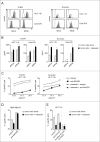Platelet-mediated shedding of NKG2D ligands impairs NK cell immune-surveillance of tumor cells
- PMID: 29308299
- PMCID: PMC5749664
- DOI: 10.1080/2162402X.2017.1364827
Platelet-mediated shedding of NKG2D ligands impairs NK cell immune-surveillance of tumor cells
Abstract
Platelets promote metastasis, among others by coating cancer cells traveling through the blood, which results in protection from NK cell immune-surveillance. The underlying mechanisms, however, remain to be fully elucidated. Here we report that platelet-coating reduces surface expression of NKG2D ligands, in particular MICA and MICB, on tumor cells, which was mirrored by enhanced release of their soluble ectodomains. Similar results were obtained upon exposure of tumor cells to platelet-releasate and can be attributed to the sheddases ADAM10 and ADAM17 that are detectable on the platelet surface and in releasate following activation and at higher levels on platelets of patients with metastasized lung cancer compared with healthy controls. Platelet-mediated NKG2DL-shedding in turn resulted in impaired "induced self" recognition by NK cells as revealed by diminished NKG2D-dependent lysis of tumor cells. Our results indicate that platelet-mediated NKG2DL-shedding may be involved in immune-evasion of (metastasizing) tumor cells from NK cell reactivity.
Keywords: NK cells; cancer; immune-surveillance; metastasis; platelets.
Figures



Similar articles
-
Increasing TIMP3 expression by hypomethylating agents diminishes soluble MICA, MICB and ULBP2 shedding in acute myeloid leukemia, facilitating NK cell-mediated immune recognition.Oncotarget. 2017 May 9;8(19):31959-31976. doi: 10.18632/oncotarget.16657. Oncotarget. 2017. PMID: 28404876 Free PMC article.
-
Platelets impair natural killer cell reactivity and function in endometriosis through multiple mechanisms.Hum Reprod. 2017 Apr 1;32(4):794-810. doi: 10.1093/humrep/dex014. Hum Reprod. 2017. PMID: 28184445
-
Shedding of endogenous MHC class I-related chain molecules A and B from different human tumor entities: heterogeneous involvement of the "a disintegrin and metalloproteases" 10 and 17.Int J Cancer. 2013 Oct 1;133(7):1557-66. doi: 10.1002/ijc.28174. Epub 2013 Apr 18. Int J Cancer. 2013. PMID: 23526433
-
NK Cell Interaction With Platelets and Myeloid Cells in the Tumor Milieu.Front Immunol. 2020 Dec 23;11:608849. doi: 10.3389/fimmu.2020.608849. eCollection 2020. Front Immunol. 2020. PMID: 33424862 Free PMC article. Review.
-
Cutting an NKG2D Ligand Short: Cellular Processing of the Peculiar Human NKG2D Ligand ULBP4.Front Immunol. 2018 Mar 29;9:620. doi: 10.3389/fimmu.2018.00620. eCollection 2018. Front Immunol. 2018. PMID: 29651291 Free PMC article. Review.
Cited by
-
Contribution of natural killer cells in innate immunity against colorectal cancer.Front Oncol. 2023 Jan 4;12:1077053. doi: 10.3389/fonc.2022.1077053. eCollection 2022. Front Oncol. 2023. PMID: 36686835 Free PMC article. Review.
-
Antibody targeting tumor-derived soluble NKG2D ligand sMIC provides dual co-stimulation of CD8 T cells and enables sMIC+ tumors respond to PD1/PD-L1 blockade therapy.J Immunother Cancer. 2019 Aug 26;7(1):223. doi: 10.1186/s40425-019-0693-y. J Immunother Cancer. 2019. PMID: 31446896 Free PMC article.
-
The GPIb-IX complex on platelets: insight into its novel physiological functions affecting immune surveillance, hepatic thrombopoietin generation, platelet clearance and its relevance for cancer development and metastasis.Exp Hematol Oncol. 2022 Apr 2;11(1):19. doi: 10.1186/s40164-022-00273-2. Exp Hematol Oncol. 2022. PMID: 35366951 Free PMC article. Review.
-
A Roadmap of CAR-T-Cell Therapy in Glioblastoma: Challenges and Future Perspectives.Cells. 2024 Apr 23;13(9):726. doi: 10.3390/cells13090726. Cells. 2024. PMID: 38727262 Free PMC article. Review.
-
From Classical to Unconventional: The Immune Receptors Facilitating Platelet Responses to Infection and Inflammation.Biology (Basel). 2020 Oct 20;9(10):343. doi: 10.3390/biology9100343. Biology (Basel). 2020. PMID: 33092021 Free PMC article. Review.
References
Publication types
LinkOut - more resources
Full Text Sources
Other Literature Sources
Miscellaneous
